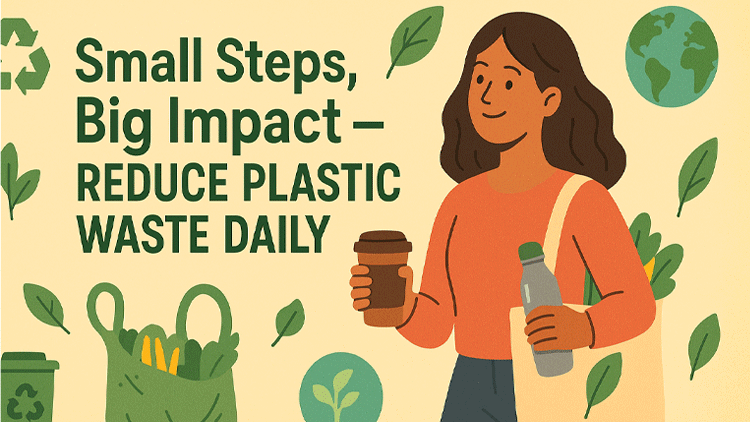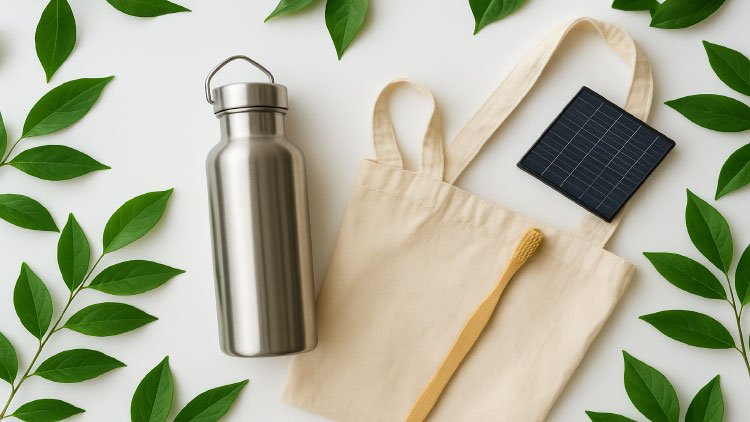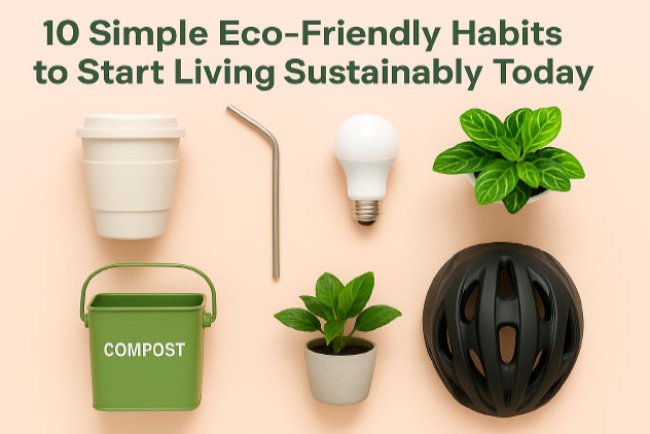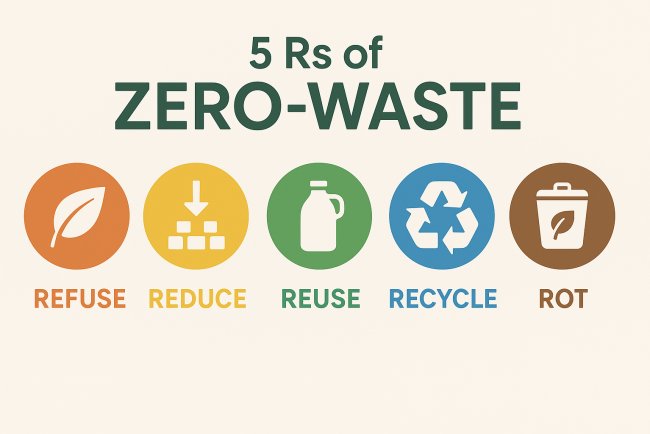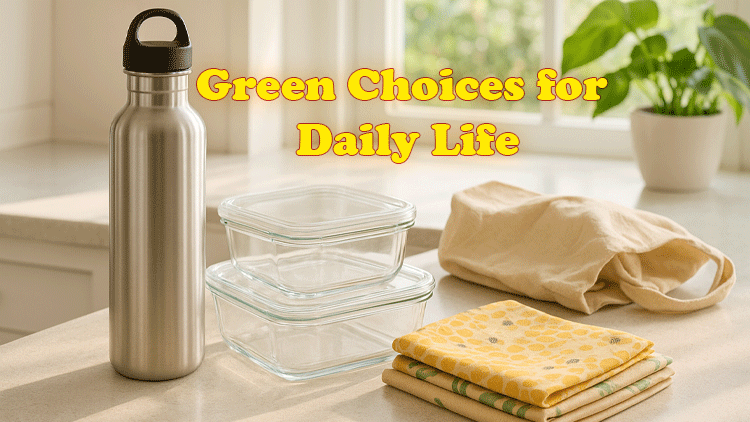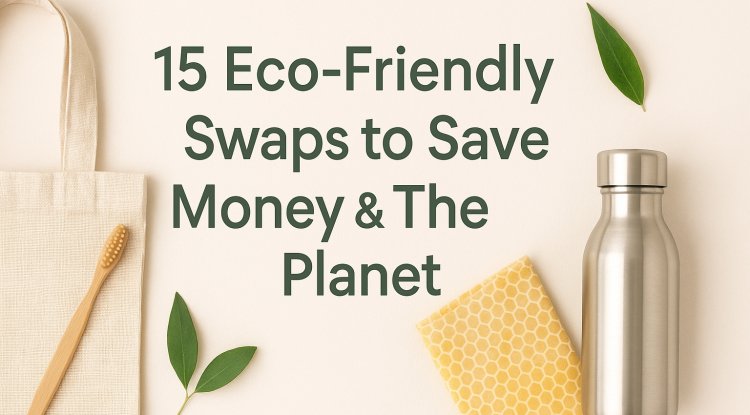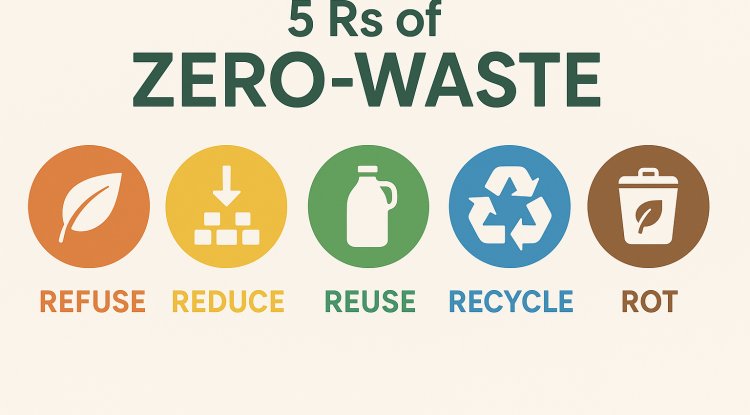How to Reduce Plastic Waste in Daily Life | Complete Guide 2025
Plastic pollution is one of the biggest environmental challenges of our time. This guide explains simple and practical steps to reduce plastic waste in daily life — from your kitchen and bathroom to shopping and office habits. Learn how to reduce plastic waste in daily life with easy eco-friendly tips. From kitchen to office, discover plastic-free solutions for a sustainable future.
How to Reduce Plastic Waste in Daily Life: A Complete Guide
Plastic is everywhere—cheap, durable, and incredibly convenient. But those same qualities make it a long-lasting problem for our oceans, soil, and even our bodies. The good news: you don’t need a perfect, zero-waste lifestyle to make a big difference. Small, consistent swaps compound fast. This guide gives you practical, budget-friendly steps to cut plastic at home, at work, and on the go—without turning your life upside down.
Why Plastic Reduction Matters
-
Health: Some plastics can leach additives into food or water, especially when heated or scratched.
-
Environment: Most plastics don’t biodegrade; they break into microplastics that persist for decades.
-
Economics: Reusing what you have saves money; smarter purchasing reduces waste-management costs.
Start with a Simple Audit (10 Minutes)
-
Scan your bin for the top five plastic items you throw away weekly (e.g., water bottles, snack packets, grocery wrappers).
-
Rank them by quantity and replaceability.
-
Choose three to tackle this month. Focus beats perfection.
High-Impact Swaps (The Big Four)
-
Bags: Keep two sturdy totes in your backpack or vehicle. Foldable cloth or jute bags fit in pockets.
-
Bottles: Carry a stainless steel or glass bottle. Refill at home, office, cafés.
-
Cups: Keep a reusable coffee/tea cup; many cafés offer discounts.
-
Cutlery & Straw: A compact utensil set and a metal/bamboo straw cover most “on-the-go” needs.
Kitchen: The Heart of Plastic Reduction
-
Bulk and Refill: Buy grains, pulses, spices, tea, and nuts from bulk stores using your own containers or paper bags.
-
Smart Storage: Replace single-use cling film with silicone lids, beeswax wraps, or placing a plate over bowls. Reuse glass jars for leftovers.
-
Appliance Habit: Skip plastic-lined microwave containers; reheat in glass/ceramic.
-
Dish Care: Use dish bars or liquid refills in your bottle. Choose plant-based sponges or coconut/wood scrubbers.
-
Food Choices: Prefer fresh produce and minimally packaged foods. Frozen veg is fine, but choose cardboard over plastic where possible.
-
Filtered Water: If safe, use home filtration instead of bottled water. For parties, rent dispensers and provide reusable cups.
Bathroom: Small Items, Big Wins
-
Toothbrush & Floss: Bamboo/biobased handles; silk or compostable floss in refillable glass dispensers.
-
Toothpaste: Tablets or concentrated pastes in metal or glass.
-
Soaps & Shampoos: Solid bars (soap, shampoo, conditioner) cut bottles dramatically. Use a soap saver bag to extend life.
-
Refillables: If bars aren’t for you, choose brands with refill pouches or returnable bottles.
-
Periods: Consider menstrual cups, washable pads, or period underwear.
-
Deodorant: Sticks in paper tubes, cream in tins, or DIY (baking soda + starch + coconut oil).
Cleaning & Laundry
-
Detergent: Concentrated powders, sheets, or bulk refills reduce plastic jugs.
-
Stain & Surface Cleaners: Multipurpose cleaning tablets dissolve in your own spray bottle.
-
Microfiber Shedding: Use a microfiber-catching laundry bag or filter; wash synthetics less often and on colder cycles.
-
Dryer: Air-dry when possible; if using a dryer, wool balls replace dryer sheets.
Closet & Fashion
-
Quality over Quantity: Fewer, better garments outlast fast fashion (and shed fewer microfibers).
-
Natural Fibers: Cotton, linen, wool, hemp breathe better and shed less plastic than polyester.
-
Care: Spot-clean, air out, and mend to extend life.
-
Secondhand: Thrift or swap to keep clothes in circulation.
On-the-Go Eating
-
Tiffins & Lunchboxes: Stainless steel or glass containers replace takeaway boxes.
-
BYO Protocol: Ask restaurants to pack in your container; choose eateries that use paper, palm leaf, or compostable ware.
-
Snacks: Prep trail mix, fruit, or homemade granola bars to avoid plastic packets.
Kids & Babies
-
Bottles & Tableware: Glass or stainless steel bottles; silicone or bamboo plates and spoons.
-
Diapers: If possible, combine cloth diapers with biodegradable liners. Even partial cloth use saves thousands of disposables.
-
Toys: Wood, silicone, or fabric toys last longer; share, swap, or borrow.
Work & Study
-
Desk Kit: Keep a mug, bottle, and cutlery at work.
-
Stationery: Refillable pens and markers; metal staplers; notebooks with recycled paper.
-
Catering: Advocate for bulk beverages, water dispensers, and real cutlery at office events.
Events & Gifting
-
Borrow or Rent: Plates, glasses, and cutlery.
-
Decor: Fabric bunting, flowers, reusable lighting instead of balloons.
-
Gifts: Experiences, edible treats in jars, plants, or handmade items. Choose paper tape and cloth wraps (Furoshiki style).
Recycling—Do It Right (But Don’t Rely on It)
-
Know Your Local Rules: Only certain plastics (often PET, HDPE) are commonly recycled. Film, sachets, and black plastics are often not.
-
Clean & Dry: Rinse containers to avoid contamination.
-
Separate Streams: Keep paper/card clean from food residue.
-
E-Waste & Batteries: Use certified drop-off points—never in household bins.
Remember: Recycling is a safety net, not the plan. Refuse, Reduce, Reuse come first.
Compost: The Hidden Plastic Solution
Organic waste in landfills creates methane and contaminates recyclables. Composting:
-
Shrinks trash volume (50%+ in many homes).
-
Avoids liners: Use a reusable bin with newspaper lining.
-
Options: Home bin, community compost, or city pickup where available.
Tech & Digital Habits
-
Cloud vs. Clutter: Fewer gadgets = fewer cables and plastic accessories.
-
Repair & Refurbish: Fix before replacing; buy refurbished devices when possible.
-
Decline Freebies: Conference swag is often low-quality plastic; say no.
Budget-Friendly Starter Kit
-
2 cloth/jute totes
-
1 stainless/glass bottle
-
1 travel mug
-
1 cutlery set + straw
-
3 glass jars (repurpose sauce jars)
-
2 food wraps or silicone lids
-
1 bar soap + shampoo bar
-
1 multipurpose cleaner tablet + spray bottle
Tip: Start with what you already own; don’t buy everything new.
30-Day Plastic-Lite Challenge (One Action per Week)
-
Week 1: Carry bottle + bag every day.
-
Week 2: Switch to bars (soap, shampoo) and refill dish liquid.
-
Week 3: Bulk-buy pantry staples; store in jars.
-
Week 4: Set up compost (or join a local program) and refine recycling.
Track your progress with a simple note on your fridge or phone.
Common Myths—Busted
-
“Biodegradable plastic is fine.” Many need industrial conditions; if littered, they behave like regular plastic.
-
“Glass is always greener.” It’s reusable and inert, but heavier. The greenest choice is reuse—whatever the material.
-
“My small actions don’t matter.” Community norms shift when individuals model change. Your choices influence family, friends, and shops.
Multiply Your Impact
-
Ask for Better: Request paper bags, refills, or returnable packaging at stores.
-
Support Low-Waste Businesses: Farmers’ markets, refill shops, and makers who use natural materials (bamboo, cotton, wood, metal).
-
Share Knowledge: Post your swaps, host a mini workshop, or start an office green team.
-
Vote with Your Wallet & Voice: Choose brands with take-back programs; encourage local policies that reduce single-use items.
Quick Reference: Swap List
-
Cling film → Beeswax wrap / silicone lid / plate-on-bowl
-
Plastic scrubber → Coconut coir / plant-based brush
-
PET bottles → Refill + filter
-
Plastic toothbrush → Bamboo handle
-
Shower gel in bottle → Bar soap
-
Liquid detergent jug → Powder, sheets, or refill
-
Disposable pads → Cup / cloth pads
-
Takeaway boxes → BYO container
-
Balloons decor → Fabric bunting/flowers
-
Tape → Paper tape / string
Final Thought
Reducing plastic isn’t about being perfect—it’s about being consistent. Start with a quick bin audit, pick three high-impact swaps, and build from there. You’ll save money, cut clutter, and feel good knowing your everyday habits are gentler on the planet.
What's Your Reaction?







